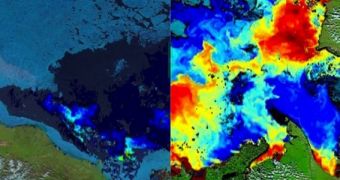A group of investigators at the NASA Jet Propulsion Laboratory (JPL) in Pasadena, California, was recently able to determine in a new study that Arctic sea ice melt rates are heavily influenced by the increasing amount of warm water rivers bring into the Arctic Ocean.
The conclusion is based on a wealth of satellite data covering multiple areas around the North Pole. This is one of the few studies currently available to look for additional sources of warming in the Arctic, apart from sea ice melt, albedo variations, and shifting oceanic heat storage patterns.
JPL researcher Son Nghiem and his team published details of their investigation in the latest online issue of the esteemed journal Geophysical Research Letters. Their study was largely centered on the influence of the Mackenzie River as it flowed into the icy Beaufort Sea, in the summer of 2012.
For this purpose, the group used data collected by the Moderate Resolution Imaging Spectroradiometer (MODIS) instrument on the NASA Terra satellite. Their work revealed a massive influx of warm water flowing into the sea, which contributed to raising the surface layer temperature levels over a large swath of the Arctic Ocean.
As the image above shows, the differences are significant, even though the readings used to create the two halves were collected less than two months apart. The inset on the left is from June 14, 2012, while the one on the right was snapped on July 5, 2012. Variations of up to 12 degrees Celsius (54ºF) can be easily observed.
“River discharge is a key factor contributing to the high sensitivity of Arctic sea ice to climate change. We found that rivers are effective conveyors of heat across immense watersheds in the Northern Hemisphere. These watersheds undergo continental warming in summertime, unleashing an enormous amount of energy into the Arctic Ocean, and enhancing sea ice melt,” Nghiem explains.
“You don’t have this in Antarctica,” he adds. The sea ices and frozen ocean surrounding the Southern Continent do not receive an influx of fresh water, since no rivers exist in Antarctica except those made of ice. As such, the South Pole is somewhat more stable in terms of temperature increases, whereas the North Pole is changing much more rapidly.
The JPL group has also determined that there are three main factors controlling the extent to which rivers affect the Arctic Ocean. The most important one is that the overall amount of water that adjacent rivers deliver to the Arctic is constantly increasing, and it will most likely continue to do so.
Another important aspect is that global warming is heating up the drainage basins of all rivers flowing into the Arctic. Therefore, more water plus more heat equals a higher and faster degree of warming for the northern ocean. The third factor is that the warm water prevents the formation of ice, decreasing the albedo of the Arctic overall, and allowing for the ocean to store more heat for longer periods of time.
Upon studying the Mackenzie River, the team determined that most of the heated waters were in June 2012 held back closer to the shorelines by a stretch of landfast sea ice, which was itself attached to the shoreline. By July, this barrier had broken, allowing warmer waters to permeate the upper layers of the Arctic Ocean. Average water temperatures jumped up by some 6.5 degrees Celsius (11.7ºF).
“When the Mackenzie River’s water is held back behind the sea ice barrier, it accumulates and gets warmer later in the summer. So when it breaks through the barrier, it’s like a strong surge, unleashing warmer waters into the Arctic Ocean that are very effective at melting sea ice,” Nghiem says.
“Without this ice barrier, the warm river waters would trickle out little by little, and there would be more time for the heat to dissipate to the atmosphere and to the cooler, deeper ocean,” he concludes.

 14 DAY TRIAL //
14 DAY TRIAL //